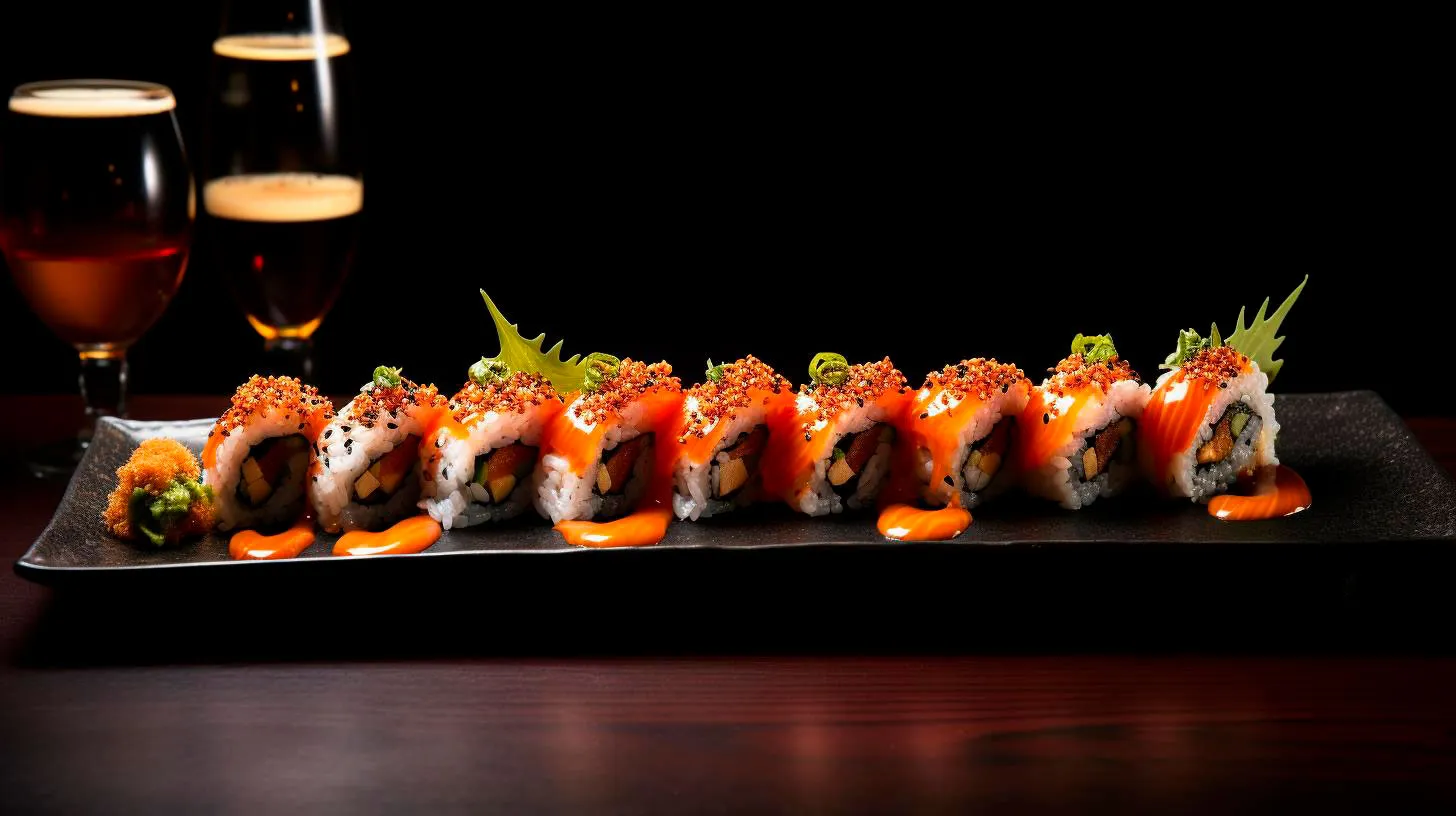Stay Safe with Sushi: Effective Measures to Prevent Cross-Contamination
Cross-contamination is a significant concern when handling sushi, as it can lead to foodborne illnesses caused by harmful bacteria and parasites. In this article, we will explore effective measures to prevent cross-contamination and ensure a safe sushi experience.
Understanding Cross-Contamination
Cross-contamination occurs when harmful bacteria or parasites are transferred from one surface or food to another. In the case of sushi, it can happen when raw fish or other ingredients come into contact with contaminated surfaces, utensils, or even other types of food. Cross-contamination poses a significant health risk, as it can lead to food poisoning and other foodborne infections.
Key Takeaways:
- Cross-contamination in sushi can lead to foodborne illnesses.
- Transferring harmful bacteria or parasites from one surface to another is the main cause of cross-contamination.
- Understanding and implementing preventive measures is crucial to ensure the safety of sushi consumption.
Preventing Cross-Contamination
When it comes to sushi preparation, following strict hygiene practices is vital. Here are some effective measures to prevent cross-contamination:
1. Clean and Sanitize Surfaces
Thoroughly clean and sanitize all surfaces and utensils used in sushi preparation. This includes cutting boards, knives, bowls, and any other food contact surfaces. Regular cleaning with hot, soapy water should be followed by sanitizing with a solution of water and bleach to eliminate any lingering bacteria or parasites.
2. Separate Raw and Cooked Ingredients
Always keep raw fish and cooked ingredients, such as vegetables or rice, separate during sushi preparation. This helps prevent any cross-contamination caused by the raw fish, which may contain harmful microorganisms. Use separate cutting boards and utensils for raw and cooked ingredients to avoid contamination.
3. Proper Hand Hygiene
Proper hand hygiene is essential to prevent cross-contamination. Always wash your hands thoroughly with soap and water before and after handling raw fish and other sushi ingredients. Avoid touching your face, hair, or any other surfaces while preparing sushi. Additionally, consider using disposable gloves to minimize direct contact.
4. Fresh and High-Quality Ingredients
Using fresh and high-quality ingredients is crucial to minimize the risk of cross-contamination. Choose reputable suppliers and ensure that the fish and other seafood used in sushi preparation are properly handled, stored, and transported. Fresh ingredients not only enhance the flavors but also reduce the risk of foodborne illnesses.
5. Proper Storage and Temperature Control
Proper storage and temperature control are essential to prevent the growth of harmful bacteria. Sushi ingredients, especially raw fish, should be stored at the correct temperature to ensure their safety. It is recommended to keep the perishable items refrigerated at temperatures below 40°F (4°C) and consume them within a short period.
6. Educate and Train Food Handlers
Education and training play a crucial role in preventing cross-contamination. Food handlers involved in sushi preparation should undergo regular training sessions to understand the importance of hygiene, proper handling, and preventive measures. By equipping them with the necessary knowledge and skills, the risk of cross-contamination can be significantly reduced.
7. Regular Inspections and Audits
Regular inspections and audits can help identify any potential cross-contamination risks in sushi preparation areas. Government health agencies often conduct checks and provide guidelines to ensure compliance with food safety standards. Following these guidelines and performing self-audits can go a long way in guaranteeing a safe sushi experience.
Conclusion
Sushi can be a delicious and healthy choice, but it is essential to take necessary precautions to prevent cross-contamination. By understanding the risks and implementing effective measures, you can enjoy your sushi without worrying about foodborne illnesses. Remember to follow proper hygiene practices, keep raw and cooked ingredients separate, and ensure the freshness and quality of the sushi ingredients. Stay safe and savor every bite of this popular Japanese delicacy!
Key Takeaways:
- Following strict hygiene practices is crucial for safe sushi preparation.
- Thoroughly clean and sanitize all surfaces and utensils used in sushi preparation.
- Keep raw and cooked ingredients separate during sushi preparation.
- Practice proper hand hygiene to prevent cross-contamination.
- Use fresh and high-quality ingredients to minimize the risk of foodborne illnesses.
- Proper storage and temperature control are essential for sushi safety.
- Regular training, inspections, and audits ensure compliance with food safety standards.
5 Key Practices to Avoid Sushi Cross-Contamination
To ensure a safe and enjoyable sushi experience, it’s important to follow key practices that minimize the risk of cross-contamination.
1. Source Fresh and High-Quality Ingredients
The freshness and quality of ingredients play a crucial role in preventing sushi cross-contamination. Opt for reputable suppliers and restaurants known for their strict quality control measures. Here are some key points to remember:
- Choose sushi-grade fish: Ensure that the fish used in sushi preparation is labeled sushi-grade, indicating that it is safe to consume raw. Fresh fish should have clear eyes and a mild oceanic smell.
- Inspect vegetables and fillings: Examine vegetables and fillings for freshness and discoloration. Avoid any ingredients that appear bruised or spoiled.
- Proper storage: If you’re making sushi at home, store ingredients in refrigerated containers or bags to maintain freshness.
By selecting fresh and high-quality ingredients, you can significantly reduce the risk of cross-contamination before even starting the sushi-making process.
2. Practice Good Hygiene
Hygiene is a critical aspect of sushi preparation that cannot be overlooked. Follow these hygiene practices to avoid cross-contamination:
- Handwashing: Thoroughly wash your hands with soap and warm water before handling any sushi ingredients. This helps eliminate any potential bacteria or viruses.
- Clean workspace and utensils: Ensure your preparation area is clean and sanitized before starting. Use separate cutting boards, knives, and utensils for different ingredients to prevent cross-contamination.
- Gloves: Consider wearing disposable gloves during the sushi-making process, especially if you have open cuts or wounds on your hands.
By maintaining proper hygiene throughout the sushi preparation, you can minimize the risk of cross-contamination and ensure a safe dining experience.
3. Separate Raw and Cooked Ingredients
One of the key points to remember in sushi preparation is separating raw and cooked ingredients to prevent cross-contamination. Here’s what you should keep in mind:
- Different cutting boards: Use separate cutting boards for raw fish and cooked ingredients like vegetables. This prevents the spread of bacteria from raw fish to other components.
- Clean knives: After cutting raw fish, make sure to clean the knife thoroughly before using it to cut other ingredients. This helps prevent any cross-contamination.
Implementing this practice ensures that raw ingredients, which are more prone to bacterial growth, do not contaminate the cooked components and vice versa.
4. Safe Refrigeration
Proper storage and refrigeration are crucial in maintaining the freshness and quality of sushi ingredients and avoiding cross-contamination. Follow these guidelines:
- Refrigerator temperature: Set your refrigerator temperature below 40°F (4°C) to prevent bacterial growth. Use a refrigerator thermometer to monitor temperature accuracy.
- Storage duration: Consume sushi ingredients within the recommended time frame. Raw fish and seafood should be used within 24 hours, while cooked ingredients can last a bit longer.
- Prevent leakage: Store sushi ingredients separately in sealed containers to avoid any potential leakage or mixing of flavors.
By refrigerating sushi ingredients properly, you can extend their shelf life and minimize the risk of cross-contamination.
5. Educate Sushi Chefs and Staff
Finally, it’s important to educate sushi chefs and staff about cross-contamination and the best practices to avoid it. Establish thorough training programs that cover the following:
- Hygiene and food safety: Train chefs and staff on proper handwashing techniques, workspace sanitization, and the importance of using separate utensils for raw and cooked ingredients.
- Quality control: Teach personnel how to inspect ingredients for freshness and identify signs of spoilage.
- Refrigeration protocols: Ensure all staff members understand the correct refrigerator temperature and storage procedures for various sushi ingredients.
By empowering sushi chefs and staff with knowledge and training, you can maintain high food safety standards and prevent cross-contamination in sushi preparation.
Key Takeaways
Follow these 5 key practices to avoid sushi cross-contamination:
- Source fresh and high-quality ingredients
- Practice good hygiene
- Separate raw and cooked ingredients
- Ensure safe refrigeration
- Educate sushi chefs and staff
By incorporating these practices into sushi preparation, you can enjoy this delectable cuisine without worrying about any potential health risks. Remember, ensuring food safety is paramount to savoring sushi’s flavors while maintaining your well-being.
Common Sources of Sushi Cross-Contamination and How to Tackle Them
In this article, we will delve into the common sources of sushi cross-contamination and discuss effective measures to tackle this issue head-on, ensuring a safe and enjoyable sushi experience.
The Risks of Sushi Cross-Contamination
Sushi cross-contamination occurs when bacteria or pathogens from one ingredient or utensil transfer onto another, compromising the overall safety and quality of the sushi. This can potentially lead to foodborne illnesses, such as salmonella, norovirus, or E. coli infections. It is crucial to address these risks to ensure the well-being of sushi consumers.
Common Sources of Sushi Cross-Contamination
While sushi is undoubtedly delicious, several factors contribute to cross-contamination issues. Understanding these common sources is the first step towards mitigating the risks and ensuring a safe dining experience. Let’s explore them below:
- Cutting Boards and Knives: Sushi chefs often use the same cutting boards and knives for different ingredients during the preparation process. This can lead to the transfer of bacteria and allergens from raw seafood to other components of the sushi.
- Cross-Contact with Seafood: Sushi rolls are typically filled with various ingredients, such as raw fish, shellfish, or cooked proteins. If these ingredients come into contact with each other, there is a risk of cross-contamination.
- Soy Sauce Dipping Bowls: Shared soy sauce dipping bowls can potentially transfer bacteria from one person to another. This happens when individuals double-dip their sushi into the communal dish.
- Condiments and Garnishes: Sushi is often complemented with condiments like wasabi, pickled ginger, and soy sauce. These toppings may become contaminated if they are used by multiple individuals or if utensils are cross-utilized.
Tackling Sushi Cross-Contamination
While the risks associated with sushi cross-contamination might seem concerning, there are several effective measures you can take to ensure a safe dining experience. Let’s discuss some key takeaways:
1. Education and Communication
Restaurants and sushi chefs play a crucial role in providing education and communicating the risks of cross-contamination to their customers. By promoting awareness, establishments empower their patrons to make informed choices and take necessary precautions.
2. Separate Cutting Boards and Utensils
Using separate cutting boards and utensils for different ingredients can significantly reduce the chances of cross-contamination during sushi preparation. This practice ensures that raw seafood and cooked proteins do not come into contact with each other.
3. Personal Soy Sauce Dipping
Encouraging individuals to have their own sauce dishes can prevent cross-contamination through double-dipping. This simple step allows sushi lovers to enjoy their favorite condiments without the risk of transmitting bacteria to others.
4. Proper Hand Hygiene and Glove Usage
Sushi chefs should prioritize strict hand hygiene practices and consider wearing disposable gloves when handling different ingredients. Regularly washing hands and changing gloves between tasks helps minimize the transfer of bacteria and allergens.
5. Fresh and High-Quality Ingredients
Using fresh, high-quality ingredients is essential in reducing the risks of sushi cross-contamination. Chefs should source their seafood from reputable suppliers, ensuring proper handling and storage throughout the supply chain.
6. Regular Cleaning and Sanitization
Establishments must maintain clean and sanitary environments, regularly disinfecting surfaces and utensils. Routine cleaning schedules help prevent the build-up of harmful bacteria and minimize the risks of cross-contamination.
In conclusion, while sushi is undoubtedly a delectable culinary delight, it is important to be aware of the potential risks of cross-contamination. By understanding the common sources of cross-contamination and implementing the recommended measures, both sushi establishments and consumers can ensure a safe and enjoyable dining experience. So next time you indulge in sushi, remember these key takeaways to savor every bite without any health concerns.
Understanding Sushi Cross-Contamination Risks & Prevention
In this article, we will dive deeper into understanding sushi cross-contamination risks and effective prevention methods.
The Risks of Cross-Contamination in Sushi
Sushi cross-contamination refers to the transfer of harmful bacteria or allergens from one food item to another, leading to potential health risks. Since sushi involves the combination of various ingredients and raw seafood, cross-contamination can occur if proper precautions are not taken. Some of the common risks associated with sushi cross-contamination include:
- Bacterial Infections: Cross-contamination can lead to the spread of bacteria like Salmonella and E. coli, resulting in foodborne illnesses.
- Allergen Exposure: Sushi often contains common allergens, such as shellfish, gluten, and soy. Cross-contamination can cause unintended exposure to allergens for individuals with allergies, leading to severe reactions.
Preventing Sushi Cross-Contamination
To ensure the safety of your sushi and prevent cross-contamination, here are some crucial steps you can follow:
1. Choose a Reputable Sushi Restaurant
When dining out for sushi, always opt for a reputable restaurant known for its hygiene standards and food safety practices. Research customer reviews and check for any reported cases of foodborne illnesses.
2. Proper Hand Hygiene
Both chefs and customers should maintain proper hand hygiene to prevent cross-contamination. Chefs must wash their hands thoroughly before handling any food, especially raw seafood. Customers should also wash their hands before consuming sushi.
3. Use Separate Utensils
Using separate utensils for each type of sushi or ingredient can significantly reduce the risks of cross-contamination. Utensils such as knives, cutting boards, and chopsticks should be cleaned and sanitized between uses.
4. Separate Preparation Areas
Avoid preparing raw sushi ingredients on the same surface where other food items are being prepared. Dedicate a specific area for sushi ingredients to prevent cross-contamination.
5. Fresh and High-Quality Ingredients
Using fresh and high-quality ingredients is crucial in preventing sushi cross-contamination. Always ensure that seafood, vegetables, and other components are fresh and sourced from reliable suppliers.
6. Allergen Awareness
If you or someone you are dining with has food allergies, inform the sushi chef about the specific allergen(s) to avoid cross-contamination. This allows them to take necessary precautions and provide suitable alternative options.
Key Takeaways
Sushi cross-contamination can pose significant risks to our health if not prevented. By following the appropriate preventive measures, we can continue to enjoy sushi without compromising our well-being. Remember these key takeaways to ensure safe sushi consumption:
- Choose a reputable sushi restaurant with good hygiene practices.
- Maintain proper hand hygiene and use separate utensils.
- Keep raw ingredients separate from other food items.
- Always use fresh and high-quality ingredients.
- Inform the chef about any allergens to avoid cross-contamination.
By being aware of the risks and taking necessary precautions, we can savor sushi with peace of mind, knowing that we are prioritizing our health and food safety. Enjoy your sushi adventure while staying safe!


